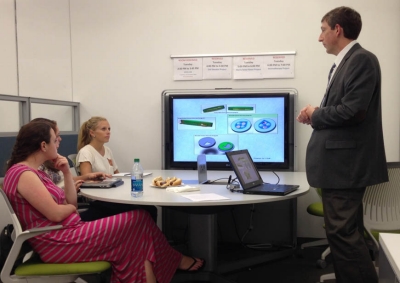ME Senior Project Makes Scents

ME senior design team members Marie Willette, Meredith Ahlmeyer and Kathryn Ginns are given an introduction to the aromatherapy device project by Dr. Mark Pizzini ’90 CLAS.
Industry sponsored projects, service learning projects, course-specific opportunities, and faculty research provide many College of Engineering students with essential hands-on experience that challenges them to take what they learn in the classroom and apply it in the real-world. Increasingly, students are collaborating with non-profit organizations and industry partners on projects ranging from a drop-foot orthotic device to a zoo animal app. These opportunities often come to fruition through the Multidisciplinary Design Lab (MDL), and typically form the basis of students’ senior design work.
One of the projects currently in the works for a team of senior Mechanical Engineering students is an aromatherapy device proposed by Villanova alumnus Dr. Mark Pizzini ’90 CLAS. In an initial meeting with Dr. Pizzini, team members Meredith Ahlmeyer, Kathryn Ginns and Marie Willette were presented with the rationale behind the concept, its range of potential uses, and the team’s role in the project (a fourth team member, Dan Furth, was unable to attend the meeting).
As an anesthesiologist, Dr. Pizzini explained the challenges presented by strong, unpleasant odors in the operating room. Surgeons try to mask odors through a variety of means, but ultimately the results are ineffective. Knowing that the sense of smell can cause physiological changes in the brain, Dr. Pizzini began searching for a solution through aromatherapy. By using essential oils embedded in an attachable mask device, noxious stimuli could be overcome, making the proposed product of interest to those in surgical areas, dental offices and nursing homes.
Given its nearly immediate effect, aromatherapy may also have applications for public use, including the suppression of air, motion and sea sickness, nausea control for sickness during pregnancy, calming effects for relaxation, and improved breathing for sports and stress-induced asthma. Dr. Pizzini explains, “There are endless possibilities for such a device.”
The student team’s assignment is to design a delivery mechanism and test prototypes, but to get to that point, a number of factors have to be addressed. “The top three considerations are that the device be wearable, easy to use and inexpensive,” says Dr. Pizzini. In addition, students will need to determine the optimal size and shape for the device, a means for variable release, and how to restrict the scent to a controlled area. The most effective form and concentration for the aroma must also be considered.
“As of now we are in the brainstorming process,” says team member Meredith Ahlmeyer. “As a group, we meet on multiple occasions each week, depending on how much work needs to be completed before a weekly meeting with our adviser, Dr. Radhakrishnan.” Team member Marie Willette adds, “I like that this project has real world impact and that we get to use everything we have learned in our engineering courses in order to complete the design process.”
The aromatherapy team will present its device, along with each Mechanical Engineering senior design team project, in April 2015.
